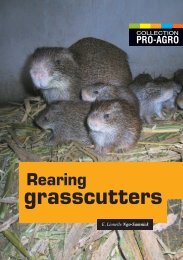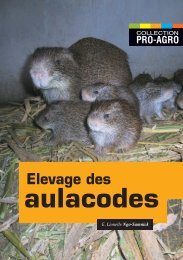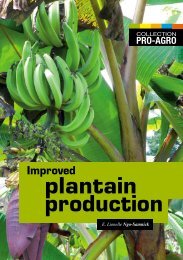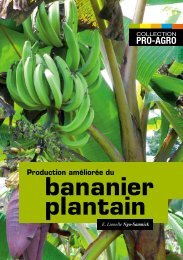Maize
Maize production and processing - CTA Publishing
Maize production and processing - CTA Publishing
Create successful ePaper yourself
Turn your PDF publications into a flip-book with our unique Google optimized e-Paper software.
Stored grain pests<br />
Most stored grain pests belong to two biological orders: Coleoptera and<br />
Lepidoptera. The main insects and pests are described in the table below.<br />
Insects and<br />
pests<br />
Symptoms<br />
Pest control<br />
The <strong>Maize</strong> weevil (Sitophilus zeamais)<br />
attacks stored cereal products<br />
such as maize, wheat and rice. The<br />
female chews through the surface<br />
of the grain, creating a hole, before<br />
depositing an egg. After a few days,<br />
the larva emerges from the egg and<br />
begins feeding on the grain.<br />
• Spread the maize out in thin layers and<br />
expose to sunlight.<br />
• Treat or mix the maize with repellent<br />
plants such as neem.<br />
• Use mechanical control such as silage<br />
transfer, shaking or winnowing to eliminate<br />
some of the insects.<br />
• Coat the maize with a film of insecticide.<br />
• Fumigate the maize with insecticide to<br />
eliminate all forms of weevil rapidly.<br />
The presence of Indian meal moth (Plodia<br />
interpunctella) and the European<br />
grain moth (Nemapogon granella) can<br />
be identified by a webbing of white silk<br />
on top of the grain.<br />
• Keep the grain stores clean and fill any<br />
holes in the walls.<br />
• Treat with aluminium phosphide<br />
(phostoxin).<br />
• Use special winnowing devices to<br />
break the infested grains.<br />
• Thresh and grind the grain as soon as<br />
possible after harvesting, then disinfect<br />
the grain store.<br />
larva<br />
The Angoumois grain moth (Sitotroga<br />
cerealella) infests the grain stock,<br />
feeding first on the germ, then the<br />
inside of the kernel. Severe attacks<br />
reduce seed viability and give the grain<br />
a stale odour.<br />
• Process with a threshing machine as<br />
soon as possible after harvesting.<br />
• Turn the grain piles regularly with a<br />
shovel.<br />
adult<br />
20








